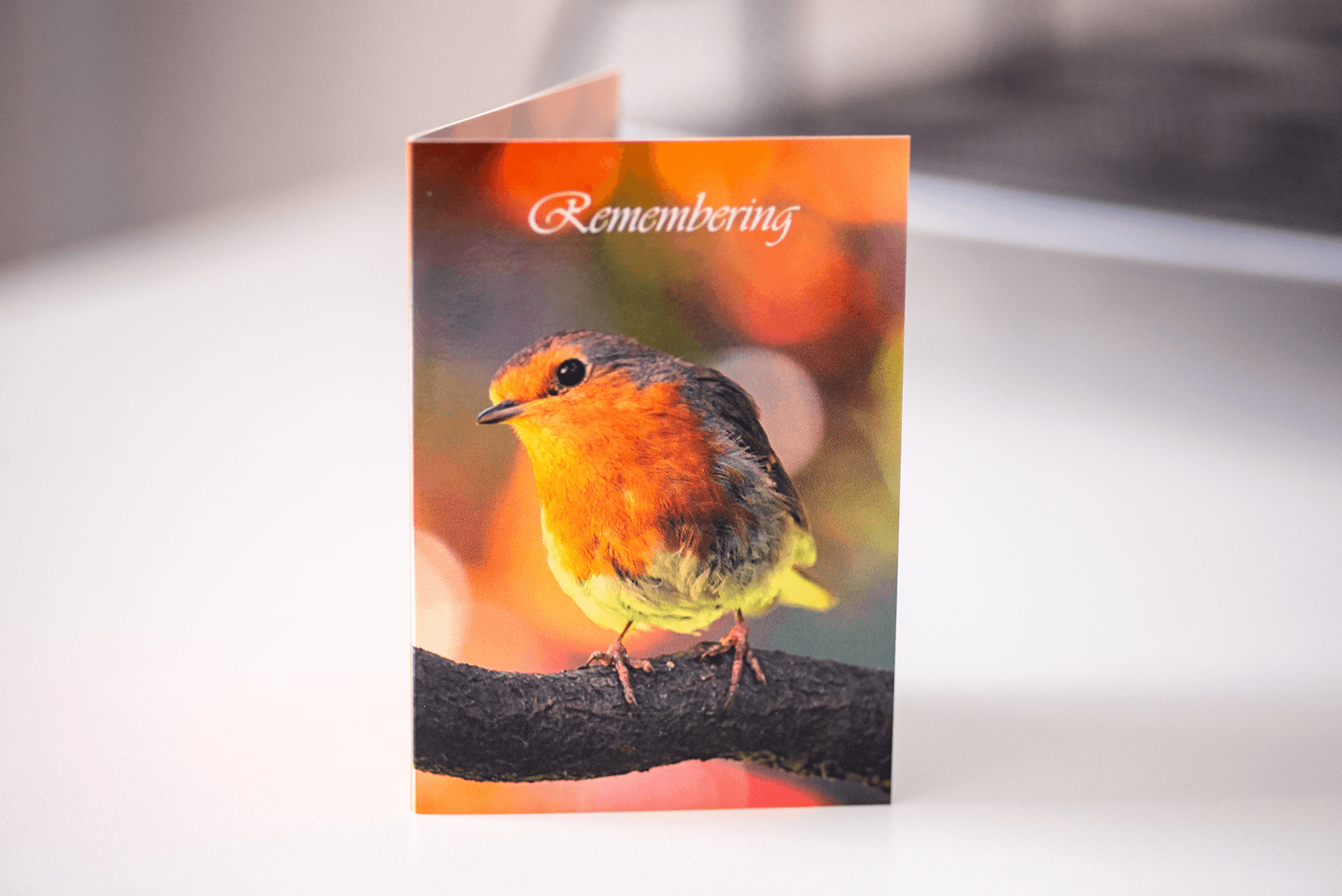Memorial Card Quality - What to expect

We put a great deal of time and a great deal of effort into ensuring all of the memorial cards we produce are of impeccable quality standards each and every time. Our production process is built around providing quality rather than trying to cut corners.
Unless you are a print professional or involved in the print industry it can be hard to tell what is good quality and what is substandard quality and what to look out for to make sure that you are getting good value. In this article we will outline exactly what to look for and where you are likely to spot quality flaws and imperfections in the memorial cards you receive.
The purpose of this article is not to down talk our competitors or expose anything, it is simply to hold ourselves and the print industry as a whole to higher standards and enlighten you the customer on how to ensure you receive the sort of quality you deserve.
Design quality checks
The sample cards on our website are designed from the outset with high quality imagery and artwork that is suitable for high quality digital printing.
When we receive the order details for your card through our website or by post or email we always ensure that we check the information & photos throughrally. This usually starts with inspection of the photo in our design software, if the photos do not meet our quality standard we always try to fix them – if we cannot fix them we will contact you to resolve the issue before printing.
Generally all of our photos are edited and cleared of minor imperfections such as dust/dirt, tears or creases if it is a scan of an older photo and imperfections in digital photos such as digital grain, distractions or colour imbalances.
We colour correct every photo that is put on our cards to ensure they print as realistically and flaw free as possible.
The Printing Process
The printing process is where a lot of print companies try to cut costs and save a few euro here and there at (generally) the sacrifice of the quality and finish of the end product. This may be ok for things like flyers or business cards but is really not ok for printing memorial cards.
Paper & Paper thickness
Paper thickness is measured in GSM (gram per square metre) and generally goes from 80gsm which would be standard printing paper to around 400gsm which would be classed as heavy card. As the GSM (thickness) gets higher the cost of paper gets drastically more expensive for digital stocks, particularly for coated paper stocks like silk or gloss that are digitally compatible.
Our memorial cards are always printed on either 350gsm or 400gsm silk card to ensure consistent colour vibrancy and stable background brightness.
Digital Printing
Unless you order a very large amount of memorial cards they are generally printed on digital printing presses with toner as opposed to ink used in Lithographic printing. Toner is basically tiny particles of plastic are attracted to the page via electromagnetism and then melted onto the page with a fuser. This is a very quick process and happens in the printing press itself. The quality output of digital presses tends to vary depending on age, cost and function of the machine.
All of our memorial cards are printed by our print partner on their HP Indigo digital presses which produce outstanding, industry leading quality that is really unmatched by anything else. The reason why we use a print partner to print our work rather than do it in house is because the higher quality, more expensive digital presses require large quantities to be ran through them to be cost effective. Since memorial cards are generally low quantity orders it would not be cost effective for us to run these calibre of printers ourselves as we specialise only in memorial printing and do not do any other type of print. Working this way ensures you get the absolute best in print quality and allows us to dedicate more time to the rest of the printing process such as design and finishing of the cards.
Laminating
All memorial cards, bookmarks & wallet cards are generally laminated with the exception of acknowledgement cards. The most popular finish is gloss lamination but some printers offer matt lamination also. The main difference between gloss and matt film apart from the finish feel would be resistance to scuffing and marking. We find that matt films tend to mark very easily whereas gloss films have very good resistance to marking and scratching.
The whole point of laminating memorial cards is to ensure they are as durable as possible and will stand the test of time, lamination helps with water & moisture resistance particularly is moist of humid environments. Although laminating can help with UV stability generally digital printing is very UV stable to begin with.
Our cards are laminated on a professional production quality laminator that uses high pressure and digitally controlled temperature to produce very consistent results that is free from defects such as air bubbles and trapped dust.
Common laminating defects
The most common laminating defect you will likely spot on a memorial card is delamination around the crease line, delamination is where the lamination film failed to adhere properly and is lifting as a result. This generally looks like little air bubbles behind the film and is very easy to spot particularly on a design there a lot of colour is used.
Another easy way to spot bad laminating is to look in the corner of the cards, if the film is lifting on its own or will lift with minimal persuasion then chances are it is either bad quality film or a bad laminating job.
Cheaper non digital grade lamination films will not adhere to digitally printed cards and will lift eventually. Using cheaper non digital compatible machines to laminate cards will also result in bad lamination and most likely will give poor results.
Cutting the cards
Once the cards are laminated the next stage is cutting the cards down to size. This is done with a guillotine that is controlled by a digital program to ensure the cards are cut to the right size. Cards that have been cut precisely by a professional will form an even & clean stack.
Although guillotining is probably the most straight forward step in producing memorial cards it is the one that requires experience to get right. Once wrong cut or one miscalculation and the whole print run will need to be done again.
Our cards are cut on a digitally controlled Ideal guillotine which is the industry leader for guillotines, we keep our blades sharp to ensure clean cuts each and every time.
Creasing the cards
Once the cards have been cut to size they are then creased down the centre so they can fold easily. Creasing properly is essential in getting and even fold and is very easy to get wrong. The general rule of thumb would be to allow 1mm either way depending on the method of creasing.
While creasing we also take the opportunity to check all the cards for defects and ensure all cards are perfect.
Dispatching Your Order
Our cards are sent our shrink wrapped in polythene plastic in stacks of either 25 or 50 depending on quantity. Although we really don’t like using plastic unnecessarily it is essential to make sure that the cards are not damaged by water while in transit. The plastic we use is also widely recycled so we kindly request for you to please try and recycling it.
We do not squeeze things into small boxes, we usually pack our cards with generous space with paper void fill to give a bit of a buffer against things like the box being crushed in transit.
All of our cards are dispatched with either An Post or by a courier (usually DPD) depending on where the customer is located. We only used signed delivery services and all orders are delivered free of charge.
If you have any questions about or cards please don’t hesitate to call us on (01) 699 1214 or email us at [email protected]. We would be more than happy to help with any questions you may have.


